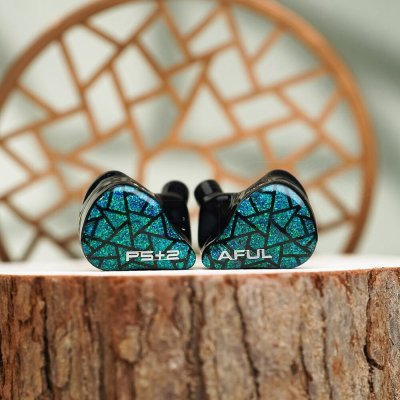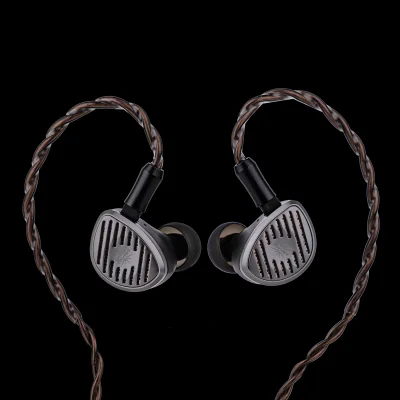Aful Performer 5+2 and Kiwi Ears Septet use 2DD+4BA+1Planar and 1DD+4BA+1Planar+1PZT driver setups respectively. Aful Performer 5+2 costs $229 while Kiwi Ears Septet costs $269. Kiwi Ears Septet is $40 more expensive. Aful Performer 5+2 holds a clear 0.8-point edge in reviewer scores (7.7 vs 6.8). Aful Performer 5+2 has significantly better mids with a 3-point edge, Aful Performer 5+2 has significantly better treble with a 2.6-point edge, Aful Performer 5+2 has significantly better dynamics with a 1.6-point edge and Aful Performer 5+2 has better soundstage with a 0.8-point edge.
Insights
| Metric | Aful Performer 5+2 | Kiwi Ears Septet |
|---|---|---|
| Bass | 8 | 6.8 |
| Mids | 8 | 5 |
| Treble | 7.6 | 5 |
| Details | 7.6 | 6.8 |
| Soundstage | 7.8 | 7 |
| Imaging | 7.9 | 6.8 |
| Dynamics | 7.6 | 6 |
| Tonality | 7.8 | 7.1 |
| Technicalities | 7.7 | 7.2 |
Aful Performer 5+2 Aggregated Review Score
Average Reviewer Scores
Average Reviewer Score:
7.7Strongly Favorable
Kiwi Ears Septet Aggregated Review Score
Average Reviewer Scores
Average Reviewer Score:
6.8Cautiously Favorable
Reviews Comparison
Aful Performer 5+2 reviewed by Jaytiss
Youtube Video Summary
Aful Performer 5+2 lands as a hybrid of the beloved Performer 5 and the punchier Explorer. The unboxing is the familiar P5 affair—same case, same style of tips—nothing flashy, but solid. The shell mirrors the P5 in size with a comfy little stabilizing wing that locks in well. No metal nozzle or front filter here, yet tip retention is secure and hassle-free. The flat 2-pin socket is straightforward, and the stock cable feels thick and supple with a reliable chin slider and handy red/blue channel markers. Overall: understated build, great ergonomics, daily-driver ready.
Sonically, this one aims neutral with a very distinct top end—clean, dynamic, incisive. Think switching from black-and-white to color; cymbals and overtones pop with a slightly crunchy/pristine edge that energizes detail without turning harsh on good recordings. Bass isn’t about sheer quantity; it’s about slam and dynamics—quick on the draw, well-controlled, and satisfying when called upon. Vocals sit a notch forward, microdetail is strong, and the overall presentation is coherent, clear, and technical with convincing stage, resolution, and imaging. Not a treble-shy or bass-bombed tuning—more a refined all-rounder for those who want clarity and bite.
Versus the original P5, the 5+2 fixes the missing “air” and soft edges, trading them for crisper transients and better extension. Compared with Explorer (a value champ), the 5+2 brings superior upper-treble reach, detail, and vocal focus. Against Performer 8 and Cantor, it feels more visceral—the P8 is smoother and more relaxed, while Cantor pulls finer microdetail but with less bass slam. Sets like Dino Quattro or J’s Estrella bring bigger fun or treble theatrics, yet the 5+2’s balance and everyday versatility win more often. Net take: a neutral-leaning, highly technical upgrade that stands tall in its bracket—easy to recommend to anyone chasing clarity, speed, and controlled impact over pure warmth or excess bass.
Jaytiss Youtube Channel
Buy Aful Performer 5+2 on HiFiGO
Ad
Price: $213
Buy Aful Performer 5+2 on HiFiGO
Kiwi Ears Septet reviewed by Jaytiss
Youtube Video Summary
The Kiwi Ears Septet is a multi-driver oddball in the best way: a single DD + 4BA + planar + PZT hybrid with an open-back shell at $259. Build is solid with a metal body, flat 2-pin sockets and a handsome modular cable; fit is stable and isolation would be strong if it weren’t vented. It’s clearly aimed at listeners who want something different in both design and presentation.
Sonically it’s a down-tilted, slightly L-shaped tuning: deep, thumpy bass, subdued upper-mids, and a sparkly 4–6 kHz region that adds air and detail. The open structure creates a speaker-like stage—wide, clean imaging with a sense of room—but it can show a hint of hiss and benefits from more power (dongle/DAP recommended) to wake up dynamics. It’s a unique, spacious listen that some will love and others won’t; while the treble and imaging impress and it earns a recommendation (even a spot in a price-tier top 10), those wanting stronger presence in vocals may prefer Kiwi Ears’ more conventional tunings or adjacent sets like Astral or Performer series.
Jaytiss Youtube Channel
Buy Kiwi Ears Septet on Linsoul
Ad
Price: $269
Buy Kiwi Ears Septet on Linsoul
Aful Performer 5+2 reviewed by Audio Amigo
Youtube Video Summary
The AFUL Performer 5+2 (Performer 7 / P7) takes the P5 recipe and adds a second 6 mm dynamic for the lows and a micro-planar for the highs, nudging MSRP to $240. Unboxing mirrors the P5: nine pairs of tips and a decent case, but the accessories feel bare-bones at this price—no foam tips and a non-modular cable, even though the included 8-wire is supple and well-behaved. Build is classic AFUL: 3D-printed resin, blended nozzle (no mesh or lip—watch tip retention), single rear vent, and striking blue-green mosaic shells inspired by Suzhou gardens—cool-wall approved with four compliments to one “meh.” Fit is semi-custom and a touch chunkier than P5; comfortable for most, a conditional pass for small ears. Note a sporadic batch quirk: some units have over-tight 2-pin sockets; exchanges fixed it for affected buyers.
Tuning sits in warm-leaning neutral territory. The dual dynamics deliver punchy, textured bass that rumbles without bloating; guitars and drums carry convincing weight. Mids are the star—rich, full-bodied, vocal-forward without shout, with clean separation and natural tone. Treble from the micro-planar is smooth yet energetic: cymbals and vocal harmonics sparkle, special effects have bite and body, and only treble-sensitives may find hot mixes a bit lively. Technicalities impress for the money—detail retrieval and nuance feel a class up—while stage and imaging are solid rather than showy.
Against peers: the Tangzu x HBB budget pick mirrors the overall tonality but P7 offers higher resolution and more treble finesse; the planar “Heyday” alternative is brighter/faster with leaner bass; versus Performer 5, P7 brings tighter low-end, smoother treble, and better extremes detail; the Fresh-collab competitor pushes vocals further forward with bigger stage but leaner lower mids. Verdict: a versatile all-rounder that suits broad libraries and even content creation thanks to its balanced tonality and detail. Not for bassheads, trebleheads, or strict Harman-lean seekers, and the accessory pack/cable quirk holds it back from a slam-dunk. For roughly $240, though, it’s a brilliant, resolving upgrade in the AFUL line.
Audio Amigo Youtube Channel
Kiwi Ears Septet reviewed by Audio Amigo
Audio Amigo Youtube Channel
Aful Performer 5+2 reviewed by Jays Audio
Youtube Video Summary
Performer 7 lands with a neutral-balanced, laid-back tuning and good treble reach. The presentation is clean and generally safe, though there’s a touch of sizzly “planar-ish” timbre up top. Technicals are solid for ~$200—slightly behind sets like Quintet and Super Mix 4, about on par with Nova. Bass from the dual 6 mm DDs is tight, controlled, and free of bleed, but lacks the slam and rumble of competitors using larger drivers; mids are well separated with decent layering.
The weak spot is vocal extension: a push around 1.5 kHz tries to bring them forward, but a dip through 3–6 kHz keeps them from opening up. Tamer upper-mids help avoid fatigue for rock/metal, yet the modest low-end impact leaves drums and basslines feeling uneventful. It’s a mid-volume set that doesn’t scale well—turning it up accentuates the 1.5 kHz emphasis and treble sizzle. Treble isn’t peaky, just a bit glassy at times; for K-pop the smoother mids can work if less extended vocals are acceptable.
As a value play, there are stronger options: Nova, Chopan, and Super Mix 4 offer better bang-for-buck; for a similar clean/neutral target, Tanchjim Origin sounds more natural with better bass texture and vocal reach, and DynaQuattro adds sub-bass and fuller vocals—none with the planar-ish timbre. Even AFUL’s own P5 is cheaper and more fun, while the Explorer undercuts the price and scales impressively. In today’s crowded market, P7 is a competent all-rounder but not distinctive enough to stand out.
Jays Audio Youtube Channel
Kiwi Ears Septet reviewed by Jays Audio
Youtube Video Summary
Kiwi Ears Septet lands as an airy, spacious, and distinctly sparkly listen with a clear bright-leaning tilt that avoids harshness. Despite a notable 5–8 kHz lift, the treble comes across refined rather than peaky, while a touch of mid-bass warmth keeps the tonality musical and natural. The result is punchy drums and momentum on rock and acoustic tracks, with technicals that punch above price—layering and separation sit around Dusk/Pilgrim territory. It’s like a more airy, sparklier Meta with less forward vocals and less artificial sheen than ultra-bright sets. The “open-back” faceplate doesn’t audibly change things, but staging still feels wide.
Fit and setup matter: a deep seal smooths treble; tips like Softears Alpha Clear or Tangzu Sancai can tame peaks. The Septet scales nicely on slower tracks up to ~80 dB, but on energetic K-pop/J-pop/hip-hop it can turn hot—hi-hats may sting if the volume creeps. Comfort is solid at mid volume for hours, though sensitive ears may feel fatigue over long sessions, especially in that 5–8 kHz zone. Vocals are set back: clean and inoffensive rather than shouty, but on busy rock they can feel a touch distant. This is a treble-forward, technical presentation; not a mid-centric vocal specialist and not a bass-head set—low end is adequate but softer in impact and pushed slightly to the back.
Versus peers: Astral is the safer all-rounder with more forward vocals and less brightness; Quintet is the vocal-oriented pick, while Septet is smoother, airier, and a bit more micro-detailed. Recent Orchestra Light (unit-dependent) sounds more V-shaped and shouty; Septet takes tuning and technicals. Odyssey wins on immersion, bass texture, and vocal pop at loud volumes, but Septet brings better air, separation, and detail at normal levels. Compared with Lush, Septet is brighter and more resolving; Lush is smoother and one of the best scalers under $300 if you like it loud. For vocals first, look to EPZ P50, Cadenza 4, or Tanjim Origin; for bassier fun under $300, consider DSKO, Estrella, Deuce, or Tros. If a sparkly, airy, technical flavor that stands apart from “Harman-by-default” is appealing, Septet is a worthwhile add to the collection.
Jays Audio Youtube Channel
Aful Performer 5+2 reviewed by Web Search
The AFUL Performer 5+2 (also listed as “Performer 7”) uses a 2DD+4BA+1 micro planar driver array and AFUL’s LC-network crossover plus a 3D-printed acoustic tube system, aiming for clean band splits without smearing. The shell also integrates a high-damping air-pressure balance system, a design AFUL has used across its line. Official listings put MSRP around $229 and outline the same core tech features.
Tonally it trends neutral with a sub-bass lift: bass has solid depth and texture, mids stay relatively linear, and the presence/treble region adds energy without veering into sharpness on most chains. Multiple reviews characterize it as warm-neutral with bass boost or slightly V-shaped depending on perspective, which matches listening notes about a lively but controlled upper end. Sensitivity and load are portable-friendly (≈109 dB, 15 Ω), so it reaches performance without demanding amplification.
Technicalities are competitive for the class: imaging is tidy with good instrument separation, micro-detail retrieval is above average, and soundstage is moderate (more width than depth). Build and comfort are typical resin-shell fare; some users note occasional lower-treble bite depending on tips and recordings, so treble-sensitive listeners may wish to pair accordingly. Overall value is strong at its price, especially if a clean, bass-supported neutral curve is the priority.
Kiwi Ears Septet reviewed by Web Search
The Kiwi Ears Septet delivers a neutral-bright sound signature characterized by clear vocals and a notably forward treble that enhances detail retrieval, particularly in female vocals and acoustic instruments. Its bass response is neutral and controlled, lacking the weight of closed-back designs but offering tight, fast decay. While this tuning excels with well-recorded tracks, it can become fatiguing with bright or poorly mastered material due to its upper-midrange and treble emphasis. The open-back design contributes to an airy presentation, though it reduces isolation significantly.
Technically, the Septet showcases a wide soundstage with precise imaging and strong microdynamics, allowing subtle instrumental textures to shine. Its seven-driver quadbrid configuration (dynamic, balanced armature, planar, and piezoelectric) integrates cohesively through a sophisticated 5-way crossover. However, the low sensitivity (95dB) demands powerful sources to avoid dynamic compression, and the open-back design makes it less suitable for noisy environments despite its comfortable fit.
Aful Performer 5+2 (more reviews)
Aful Performer 5+2 reviewed by Z-Reviews
Youtube Video Summary
Naming drama aside (P5+2? just call it Performer 7), this Aful packs a quirky driver party: 2DD for low end, 4 BA split across mids/treble, plus a tiny micro-planar for the highest sparkle, all marshaled by Aful’s neat miniature crossover. The shells are lightweight, comfy and prettier than they need to be; the cable feels “don’t bother swapping” nice, with 3.5 or 4.4 options. The box is loaded with silicone tips but no foam—a miss, because the right seal changes everything. Price target sits around $250, which sets expectations high but not ridiculous.
Stock silicone yields a surgical, respectful tuning with bass that skews neutral and controlled. Swap to well-sealing foam or hybrids and feed a juicy source (warm Class A or tubes) and the set wakes up—stage snaps into a cohesive scene right in front, imaging gets laser-etched, and that micro-planar adds a pinch-of-salt treble spice without turning harsh. It’s an up-close presentation—sometimes almost claustrophobically detailed—in the best way: think “men with trumpets in the head,” precise placement, and excellent extension up top. Not as rowdy as the Explorers; more like a surgeon in a Hawaiian shirt—technical, but with a wink.
Practical upside: the clarity and positioning make this great for gaming and even viable for mixing/mastering checks; just don’t crank it into pain territory. Bass stays tight and responsive, treble sails high, and coherence holds. Tip and source matter a lot: with foam + warm power, it sings; with plain silicone, it’s merely polite. Final tally: a confident 8.5/10—doing a lot right at its price, dinged half a point for making everyone do math on the name.
Z-Reviews Youtube Channel
Aful Performer 5+2 reviewed by Super* Review
Youtube Video Summary
Aful’s Performer 5+2 upgrades the original hybrid with 2DD + 4BA + 1 micro-planar tweeter and lands around $240–$250. The unboxing is practical: three sets of silicone tips, a pocketable puck case, and a soft, nicely draping cable (available in 4.4 or 3.5), though the braid can look a bit loose and the pre-formed hooks run large. The resin shells shift between blue and green under different light; fit is medium-large, very stable, and comfortable once the right tips are found. Note the narrow nozzle without a retaining lip and partially exposed bores/filters—tip grip is key and a little care prevents ear-gunk ingress.
Tonally this leans mild V-shaped: a clean midrange with a confident bass boost, a touch of lower-treble presence for bite, and well-extended air up top. The result is more incisive and punchy than the original P5, with clearer on/off transients that aid separation and layering. Trade-offs show as a hint of gritty/plasticky treble texture on cymbals and brushes—not harsh, but less natural than ideal—while the bass stays tight and exciting.
Against Aful’s Explorer, this sounds brighter, more spacious, and more technical; Explorer plays warmer/denser with smoother treble but less openness. Versus the pricier Thieaudio Oracle MK3, tuning is broadly similar: Oracle is smoother and deeper with a softer attack, while the Performer 5+2 brings more snap and engagement for less money. As a modern mid-tier hybrid, it absolutely still has a place—energetic, spacious, and well-executed—earning a solid four stars.
Super* Review original ranking
Super* Review Youtube ChannelAful Performer 5+2 reviewed by Kois Archive
Kois Archive Youtube Channel
Aful Performer 5+2 reviewed by Gizaudio Axel
Gizaudio Axel original ranking
Gizaudio Axel Youtube ChannelAful Performer 5+2 reviewed by Audionotions
Aful Performer 5+2 reviewed by Tim Tuned
Kiwi Ears Septet (more reviews)
Kiwi Ears Septet reviewed by Head-Fi.org
Aful Performer 5+2 Details
Driver Configuration: 2DD+4BA+1Planar
Tuning Type: Neutral with Bass Boost
Brand: AFUL Top AFUL IEMs
Price (Msrp): $229
Support our free service! Buying through our affiliate links costs you nothing extra:
Kiwi Ears Septet Details
Driver Configuration: 1DD+4BA+1Planar+1PZT
Tuning Type: Neutral, Bright
Brand: Kiwi Ears Top Kiwi Ears IEMs
Price (Msrp): $269
Support our free service! Buying through our affiliate links costs you nothing extra:
Aful Performer 5+2 User Review Score
Average User Scores
Average User Score: n/a
Based on 0 user reviews
No user reviews yet. Be the first one who writes a review!
Kiwi Ears Septet User Review Score
Average User Scores
Average User Score: n/a
Based on 0 user reviews
No user reviews yet. Be the first one who writes a review!
Aful Performer 5+2 Gaming Score

Gaming Score & Grade
- The gaming score is prioritizing technical capabilities of the IEM (Separation, Layering, Soundstage) and good value.
Gaming Score
7.7Gaming Grade
AKiwi Ears Septet Gaming Score

Gaming Score & Grade
- The gaming score is prioritizing technical capabilities of the IEM (Separation, Layering, Soundstage) and good value.
Gaming Score
7.1Gaming Grade
A-Aful Performer 5+2 Scorings
Average Technical & Tuning Grades
Average Tunign Grade
A- Tuning feels well executed, keeping a natural flow across the spectrum. Switching genres feels seamless.
Average Technical Grade
A- Overall technical control is strong, presenting instruments with clarity and sensible staging. Textures are portrayed with satisfying clarity.
Kiwi Ears Septet Scorings
Average Technical & Tuning Grades
Average Tunign Grade
A-- Expect an inviting tonal blend that adapts well to genres while staying largely composed. It strikes a nice blend of warmth and clarity.
Average Technical Grade
A-- Technical chops are reliable, pairing tidy separation with a soundstage that stays conservative. Micro-detail is decent, though never spotlighted.
Aful Performer 5+2 User Reviews
"This is an example review"
Pros
- Example pro 1
- Example pro 2
Cons
- Example con 1
- Example con 2
Share your experience and build your personal ranking list.
You need to be signed in to write your own reviewKiwi Ears Septet User Reviews
"This is an example review"
Pros
- Example pro 1
- Example pro 2
Cons
- Example con 1
- Example con 2
Share your experience and build your personal ranking list.
You need to be signed in to write your own reviewFind your next IEM:
IEM Finder Quiz
newIEM Comparison Tool
newVS
























